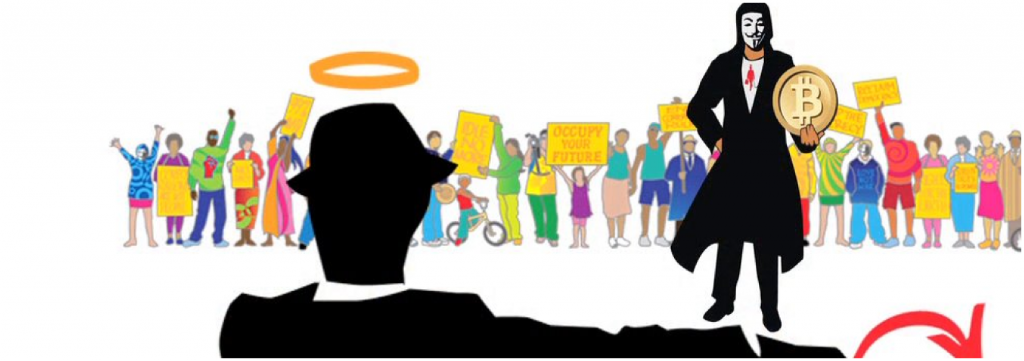A QUICK HISTORY OF CRYPTOCURRENCIES BBTC — BEFORE BITCOIN
by Ian Grigg
Before Bitcoin, there was cryptocurrency. Indeed, it has a long and deep history. If only for the lessons learned, it is worth studying, and indeed, in my ABC of Bitcoin investing, I consider not knowing anything before Satoshi’s paper as a red flag. Hence, a very fast history of what came before.
Early Days
The first known (to me) attempt at cryptocurrencies occurred in the Netherlands, in the late 1980s, which makes it around 25 years ago or 20BBTC. In the middle of the night, the petrol stations in the remoter areas were being raided for cash, and the operators were unhappy putting guards at risk there. But the petrol stations had to stay open overnight so that the trucks could refuel.
Someone had the bright idea of putting money onto the new-fangled smartcards that were then being trialed, and so electronic cash was born. Drivers of trucks were given these cards instead of cash, and the stations were now safer from robbery.
At the same time the dominant retailer, Albert Heijn, was pushing the banks to invent some way to allow shoppers to pay directly from their bank accounts, which became eventually to be known as POS or point-of-sale.
Digital Cash
Even before this, David Chaum, an American cryptographer, had been investigating what it would take to create electronic cash. His views on money and privacy led him to believe that in order to do safe commerce, we would need a token money that would emulate physical coins and paper notes: specifically, the privacy feature of being able to safely pay someone hand-to-hand, and have that transaction complete safely and privately.
As far back as 1983 or 25BBTC, David Chaum invented the blinding formula, which is an extension of the RSA algorithm still used in the web’s encryption. This enables a person to pass a number across to another person, and that number to be modified by the receiver. When the receiver deposits her coin, as Chaum called it, into the bank, it bears the original signature of the mint, but it is not the same number as that which the mint signed. Chaum’s invention allowed the coin to be modified untraceably without breaking the signature of the mint, hence the mint or bank was ‘blind’ to the transaction.
All of this interest and also the Netherlands’ historically feverish attitude to privacy probably had a lot to do with David Chaum’s decision to migrate to the Netherlands. When working in the late 1980s at CWI, a hotbed of cryptography and mathematics research in Amsterdam, he started DigiCash and proceeded to build his Internet money invention, employing amongst many others names that would later become famous: Stefan Brands, Niels Ferguson, Gary Howland, Marcel “BigMac” van der Peijl, Nick Szabo, and Bryce “Zooko” Wilcox-Ahearn.
The invention of blinded cash was extraordinary and it caused an unprecedented wave of press attention. Unfortunately, David Chaum and his company made some missteps, and fell foul of the central bank (De Nederlandsche Bank or DNB). The private compromise that they agreed to was that Digicash’s e-cash product would only be sold to banks. This accommodation then led the company on a merry dance attempting to field a viable digital cash through many banks, ending up eventually in bankruptcy in 1998. The amount of attention in the press brought very exciting deals to the table, with Microsoft, Deutsche Bank and others, but David Chaum was unable to use them to get to the next level. At one point Microsoft offered Chaum $180 million to put DigiCash on every windows PC. But Chaum that it was not enough money, and the deal fell through, and Digicash ran out of money.
Second Wave – Web Based Money
On the coattails of Digicash there were hundreds of startups per year working on this space, including my own efforts. In the mid 1990s, the attention switched from Europe to North America for two factors: the Netscape IPO had released a huge amount of VC interest, and also Europe had brought in the first regulatory clampdown on digital cash: the 1994 EU Report on Prepaid Cards, which morphed into a reaction against DigiCash.
Yet, the first great wave of cryptocurrencies spluttered and died, and was instead overtaken by a second wave of web-based monies. First Virtual was a first brief spurt of excitement, to be almost immediately replaced by PayPal which did more or less the same thing.
The difference? PayPal allowed the money to go from person to person, whereas First Virtual had insisted that to accept money you must “be a merchant,” which was a popular restriction from banks and regulators, but people hated it. PayPal also leapt forward by proposing its system as being a hand-to-hand cash, literally: the first versions were on the Palm Pilot, which was extraordinarily popular with geeks. This geek-focus was quickly abandoned as PayPal discovered that what people — real users — really wanted was money on the web browser. Also, having found a willing userbase in the eBay community, its future was more or less guaranteed as long as it avoided the bank/regulatory minefield laid out for it.
As PayPal proved the web became the protocol of choice, even for money, so Chaum’s ideas were more or less forgotten in the wider western marketplace, although the tradition was alive in Russia with WebMoney, and there were isolated pockets of interest in the crypto communities. In contrast, several ventures started up chasing a variant of PayPal’s web-hybrid: gold on the web. The company that succeeded initially was called e-gold, an American-based operation that had its corporation in Nevis in the Caribbean.
e-gold was a fairly simple idea: you send in your physical gold or ‘junk’ silver, and they would credit e-gold to your account. Or you could buy new e-gold, by sending a wire to Florida, and they would buy and hold the physical gold. By tramping the streets and winning customers over, the founder managed to get the company into the black and up and growing by around 1999. As e-gold the currency issuer was offshore, it did not require US onshore approval, and this enabled it for a time to target the huge American market of ‘goldbugs’ and also a growing worldwide community of Internet traders who needed to do cross-border payments. With its popularity on the increase, the independent exchange market exploded into life in 2000, and its future seemed set.
The Regulatory Bust
e-gold however ran into trouble for its libertarian ideal of allowing anyone to have an account. While in theory this is a fine concept, the steady stream of ponzis, HYIPs, ‘games’ and other scams attracted the attention of the Feds. In 2005, e-gold’s Florida offices were raided and that was the end of the currency as an effective force. The Feds also proceeded to mop up any of the competitors and exchange operations they could lay their hands on, ensuring the end of the second great wave of new monies.
In retrospect, 9/11 marked a huge shift in focus. Beforehand, the USA was fairly liberal about alternative monies, seeing them as potential business, innovation for the future. After 9/11 the view switched dramatically, albeit slowly; all cryptocurrencies were assumed to be hotbeds of terrorists and drugs dealers, and therefore valid targets for total control. It’s probably fair to speculate that e-gold didn’t react so well to the shift. Meanwhile, over in Europe, they were going the other way. It had become abundantly clear that the attempt to shut down cryptocurrencies was too successful, Internet business preferred to base itself in the USA, and there had never been any evidence of the bad things they were scared of. Successive generations of the eMoney law were enacted to open up the field, but being Europeans they never really understood what a startup was, and the less-high barriers remained deal killers.
Which brings us forward to 2008, and the first public posting of the Bitcoin paper by Satoshi Nakamoto.
Conclusion
What’s all this worth? The best way I can make this point is an appeal to authority:
Satoshi Nakamoto wrote, on releasing the code:
> You know, I think there were a lot more people interested in the 90′s,
> but after more than a decade of failed Trusted Third Party based systems
> (Digicash, etc), they see it as a lost cause. I hope they can make the
> distinction that this is the first time I know of that we’re trying a
> non-trust-based system.
Bitcoin is a result of history; when decisions were made, they rebounded along time and into the design. Nakamoto may have been the mother of Bitcoin, but it is a child of many fathers: David Chaum’s blinded coins and the fateful compromise with DNB, e-gold’s anonymous accounts and the post-9/11 realpolitik, the cypherpunks and their libertarian ideals, the banks and their industrial control policies, these were the whole cloth out of which Nakamoto cut the invention.
And, finally it must be stressed, most all successes and missteps we see here in the growing Bitcoin sector have been seen before. History is not just humming and rhyming, it’s singing loudly.
This article is reprinted with permission from financialcryptography.com.
The post A Quick History of Cryptocurrencies BBTC — Before Bitcoin appeared first on Bitcoin Magazine.














